ATTENTION: If you have an infestation of mites, here’s some information:
Controlling Mites in Tree Swallow Nest Boxes
At Your Boxes:
Most nestlings have fledged. A few late nests, or renests, may still be active. It’s time to check inside those boxes whose nestlings you know have left for certain. And when you do, it’s almost guaranteed you’re going to discover ectoparasites of Tree Swallows.
If you plan to remove old nests bring disposable gloves and a trash bag. Also, you might want to collect a few nests to examine for those Tree Swallow ectoparasites. If so, take along some large zip-lock bags. Although you may think this ranks pretty high on the “ick” scale, it can actually be pretty fascinating. It’s important to realize that all songbirds have both ectoparasites (little critters that live on a bird’s outer body surfaces) and endoparasites (little critters that enter a host bird’s body and live in or on the bird’s tissues or organs). It’s a fact of life. Below: a bird flea greatly magnified.
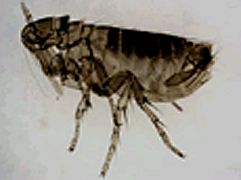
To familiarize yourself in advance with swallow ectoparasites check the Purple Martin Conservation Association’s outstanding parasite page. Purple Martins are large swallows that also host most of the same types of ectoparasites as Tree Swallows.
Concepts:
Can you resume checking boxes where young have fledged?
- Yes, but be absolutely certain no live young remain in the box before you go near or open it!! Be positive feeding has stopped. If it’s day 22 or later, with no sign adults are feeding nestlings, take a peek.
- Open the box a crack, making sure there are no living young inside.
- Determine the number of nestlings fledged by subtracting the number of dead in the box, if any, from the number counted alive at day 12 (or your closest count day before day 12).
What is the nest like inside now?
- Wear disposable gloves handling old nests.
- Late-stage nests are apt to be fouled with feces and smelly.
- Dead nestlings, if any, add to the unsanitary conditions.
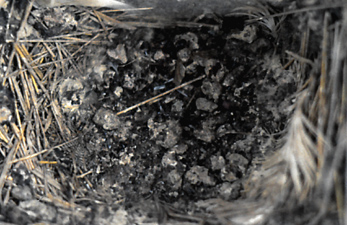
Collect a couple nests to examine for ectoparasites of Tree Swallows:
- Stand upwind to avoid blowing nest debris.
- Remove the nest. Most of it should come out in one or two pieces.
- If the nest has dead nestlings remove the nest from the box but don’t use it for ectoparasite examination; too nasty!
- Put each nest to be examined in a zip-lock bag and seal tightly.
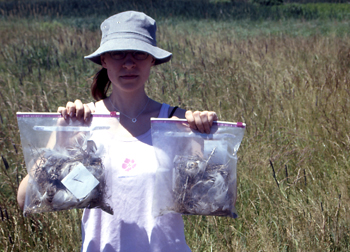
- Take nests elsewhere for examination. Not inside your house!
- Put a weighted sheet of newspaper or cardboard down to give background visibility and to make clean-up easier.
- Wearing gloves, remove a nest from its bag, put it on the paper, and pull it apart.
- Check out the little crawly things. A magnifying glass would help.
- If you don’t want them crawly, microwave the bagged nest briefly. (But they’ll be harder to see if they aren’t moving).
What Tree Swallow ectoparasites should you find?
- Most Tree Swallow nests are loaded with bird fleas, both larvae (the white curly things (below left) and adults (below right). These fleas specialize on cavity-nesting birds. Fortunately, they won’t attack you or your dogs or cats.


Sometimes, there may also be pupal cases of blood-sucking blowflies (below).

- There may also be bird lice and mites. Lice can be hard to find, but mites infestations may become heavy enough to spot easily. Mites look like little specks, but don’t look too closely at little specks – they can jump, on you!
- The tiny red specks on flanges of the nestling below are blood-sucking mites.
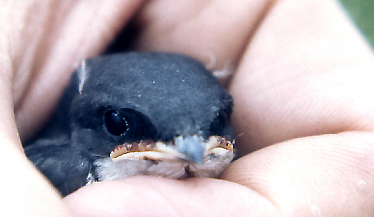
How did Tree Swallow ectoparasites get into the nests?
- Adult fleas, mites, and lice don’t fly. Instead, they ride in on adult swallows.
- Once in a box, some parasites, especially mites, remain long after the swallows have left, overwintering without food, waiting for the birds’ spring return.
- Blowfly adults are attracted by nest odor. They fly in and lay eggs in nest material. Their larvae suck body fluids from nestlings.
Don’t ectoparasites harm nestlings?
- There is considerable debate regarding whether parasite infestations are damaging for songbird nestlings. In sum, while it’s probably rare for ectoparasites to kill nestlings directly, there are several possible indirect dangers from heavy infestations.
- For instance, although research has shown blowflies have slight overall costs to nestling health, high blowfly loads may cause anemia, which could slow nestling growth, making them indirectly more susceptible to starvation and hypothermia.
- Heavy ectoparasite infestations can also depress nestling immune systems, harming their ability to resist diseases and environmental stress, leaving them in poorer condition and less apt to survive after fledging.
- In addition, ectoparasites have the potential to transmit infectious diseases directly to their hosts.
- It’s also likely that effects of ectoparasites become more severe when environmental conditions deteriorate during cold snaps or rainy periods.
- In extreme cases, some ectoparasite infestations can have disastrous effects. Note the mites in the photo below, swarming around an entrance hole. The photographer, Sal the Butterfly Hunter, believed the swallow parents refused to enter the box because of the thousands of mites present. As a result, the six nestlings inside died just before they were due to fledge.
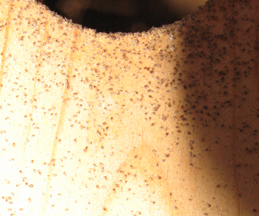
Here’s information on controlling parasitic mites in Tree Swallow boxes
Some endoparasites and subcutaneous parasites can damage tissue in ways that ultimately cause death.
- The unfortunate nestling below was host to the subcutaneous blowfly larvae that penetrated tissues in its head and destroyed its eyes. One larva can be seen exiting the face of the nestling. The gruesome picture is from Dick Stauffer.

- Here’s a link to an excellent discussion of life cycles and effects of both ectoparasitic and subcutaneous blowflys on nestling birds.
Are all those crawly critters in old nests ectoparasites?
- No, some critters in nests are harmless. In fact, some may actually be helpful.
- Some eat bird feces, nest material, or cast off feather sheaths and skin fragments.
- Dead nestlings attract insect scavengers, including carrion beetles. Some of these are reported to attack living nestlings.
Questions for the next Topic: Independent Juvenile Tree Swallows
- Can you tell juvenile Tree Swallows from adults?
- What are juveniles doing?
- What behaviors do they show?
—————————————————————————
Home: Tree Swallow Nest Box Projects
Creating Tree Swallow Nest Box Projects
Spring Return
Nesting Season Behavior
Song and Calls
Nest Site Claiming
Pair Formation
Nest Building
Bird Flight
Mating and Paternity
Diary of One Season at Salmon Creek
Monitoring Nest Boxes and Keeping Records
Making Box Checks Keeping Box Records Control Sheets Season Summaries Print Sheets
Banding Your Tree Swallows Banding Adults Banding Nestlings
Tree Swallows in Research Research Bibliography Glossary of Terms